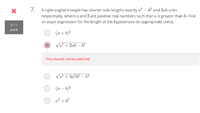
Using Pythagoras c2 = a2 + b2 I substituted my values and obtained the following:
c2 = (a2 - b2)2 + (2ab)2
After distributing and combining like terms, I obtain
c = √[a4 + 2a2b2 + b4]
I couldn't figure out how to algebraically manipulate this to match any of the answers in the photo above. So I selected something that closely resembles my answer. Thank you for reading.
c2 = (a2 - b2)2 + (2ab)2
After distributing and combining like terms, I obtain
c = √[a4 + 2a2b2 + b4]
I couldn't figure out how to algebraically manipulate this to match any of the answers in the photo above. So I selected something that closely resembles my answer. Thank you for reading.
